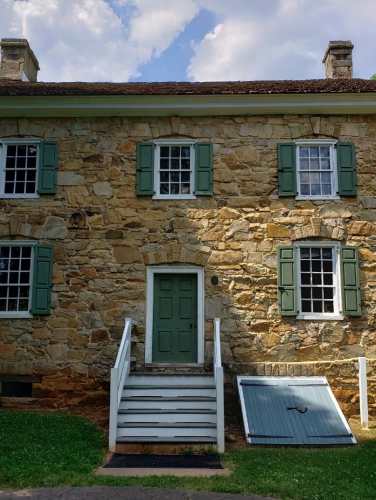
Hezekiah Alexander House
(ca. 1774)
Charlotte’s oldest extant building was the home of a framer of North Carolina’s first Constitution and Bill of Rights.
3500 Shamrock Dr, Charlotte, NC 28215
The Hezekiah Alexander House is the oldest surviving building in Mecklenburg County and likely the last standing home of a framer of North Carolina’s first Constitution and Bill of Rights. Indeed, the house is the last remaining structure of Charlotte’s Revolutionary War history.
Property Quick Links
Born in Cecil County, Maryland, Hezekiah Alexander (1722-1801) emigrated to North Carolina from Pennsylvania with his wife Mary Sample, their five children, and Hezekiah’s brother John McKnitt Alexander (1733-1817). The brothers quickly established themselves in Mecklenburg County as farmers and landowners. Although trained as a blacksmith, farming provided the source of Hezekiah’s fortune. On April 1, 1767, he purchased from his brother a 300+ acre tract of land located on a branch of Sugar Creek. It was here that in 1774 he built a stone house to accommodate a growing family that by 1775 numbered ten children, all of whom survived to adulthood.
Hezekiah served as an elder of Sugaw Creek Presbyterian Church and a trustee of Queens College. Chartered in 1771, the school was renamed Liberty Hall in 1774. With the approaching Revolution, Hezekiah became increasingly involved in the events that would culminate in independence from Great Britain. He became a member of the Mecklenburg County Committee of Safety in 1775. On August 21 of that year, Hezekiah was appointed by the Provincial Congress meeting in Hillsborough to the Salisbury District Committee of Safety, the local governing body for a multi-county area. In November 1776, Hezekiah joined other state delegates at Halifax to form the Fifth Provincial Congress that was charged with the task of writing the first state constitution. After the Halifax Congress, he joined the Fourth Regiment of North Carolina Troops as Paymaster.
The labor of at least 17 enslaved people ensured the security of the Alexander family, from the construction of the Alexander House to the operation of the family’s expanding farming enterprises. Those enslaved persons enable Hezekiah to raise crops and livestock for both sustenance and income. Although tobacco was the primary cash crop, the farm also produced corn, peaches, other foods, and textile crops like flax and cotton. Livestock included cattle, horses, mules, hogs, chickens, and turkeys.
Architecturally, the Hezekiah Alexander House reflects the influence of the German emigrants who came to North Carolina from Pennsylvania in the 1750s and 1760s. During that period several thousand families settled in Mecklenburg and the adjoining counties. Many of those settlers constructed houses of native stone like the Alexander House and similar in form to houses built by the Germans in Pennsylvania and the Dutch in the Hudson Valley. The Hezekiah Alexander House is one of the few surviving examples of this architectural type in North Carolina.

